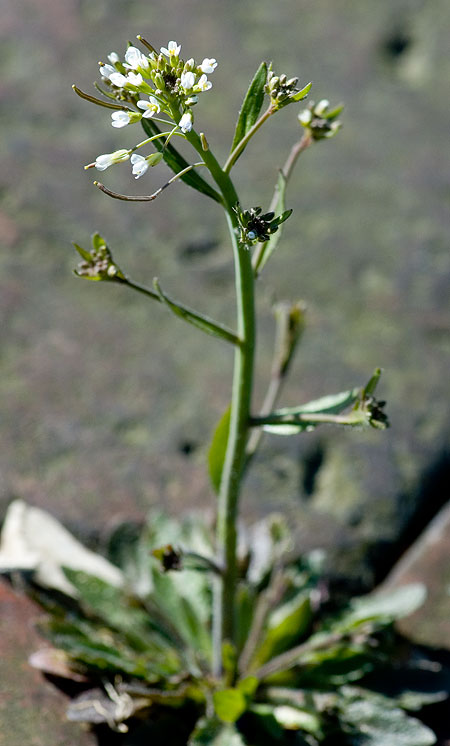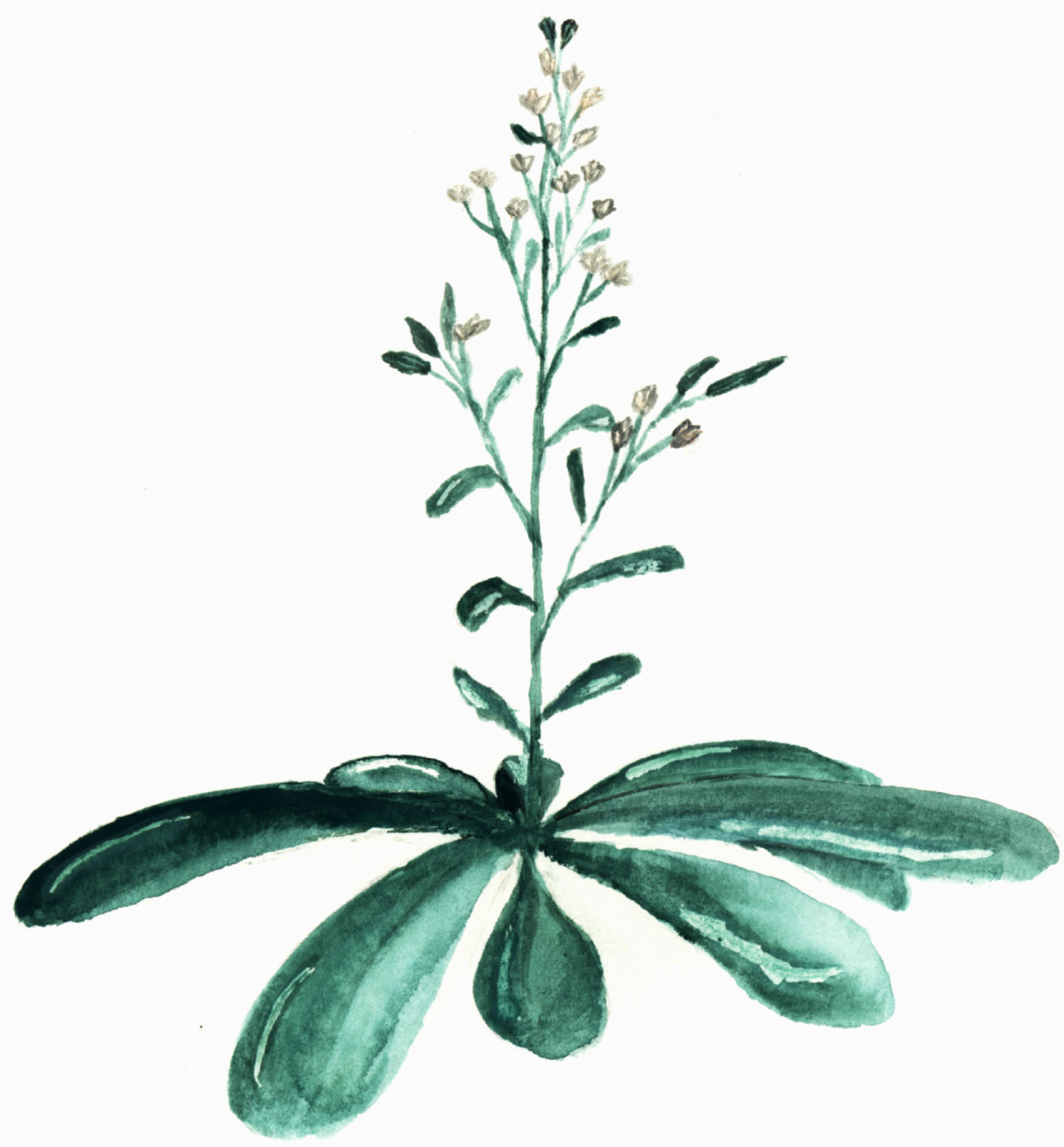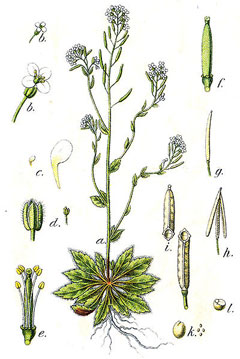Arabidopsis thaliana
Thale cress Arabidopsis thaliana
The thale cress (Arabidopsis thaliana ) is also known as thale cress or Gänserauke and is a flowering plant in the family (Brassicaceae ); it is relatively common in Eurasia.
Description
The arabidopsis is an inconspicuous, low, annual, herbaceous plant that reaches the stature heights of up to 30 centimeters. The basal leaves are arranged in rosettes and their stem is round. The leaves at the base are usually serrated, however, the stem leaves mostly entire. It flowers white and the main flowering period is from April to May The flowers are two to four millimeters in size. The plant also has fruit pods that can be 10 to 20 millimeters long. It is deeply rooted to 40 centimeters.
Dissemination
The arabidopsis, of course, is widely distributed in the temperate climates of the northern hemisphere of the Old World. The overall natural range extends from North Africa to the Indian subcontinent and all over Europe via Siberia to eastern Asia.
The arabidopsis is Central Europe Apophyt a so-called because the original native forest on dry marginal areas type changed to anthropogenic sites, than in Central Europe about 7000 years ago, forests were cleared by people in order to make room for farmland. These locations were more open than most natural and they were disturbed regularly and thus offered the arabidopsis optimal living conditions.
In many parts of the world with a temperate climate, the thale cress is a neophyte.
The arabidopsis typically grows in the field accompanying hall, like on open sandy soils or in loose Magerrasen.
Ecology
The arabidopsis is an annual, winterannuell ( or two year).
The flowers are small " nectar leading funnel flowers " because of its blandness is the insects visit only sparse, but instead takes place at 99% self-pollination, although the cross-pollination by solitary bees, Fly and thrips is meaningful.
The plant flowers from April to May, when typical arable weed but they can bloom even later.
The pods are elongated after flowering and contain 20-30 seeds durable than light to germinate; because the seed coat is produced in wet short Klebfäden a Klebausbreitung the seeds possible and unintentional spread by humans with Earth.
The pods themselves are wind spreader.
Fruit ripening starts from June.
Systematics and history of research
In the sixteenth century the arabidopsis by Johannes Thal was described for the first time and bears the name in the specific epithet. He found her in resin and named it Pilosella siliquosa. Since then, this species has been renamed several times. Several varieties have been described, but currently none of them valid.
As a scientific first publication applies Carl Linnaeus: Species Plantarum 2, 1753, p 665, under the names of species Arabis thaliana. Gustav Heynhold presented in Flora of Saxony, 1, 1842, pp. 538 with this type as type species under the currently valid name of the genus Arabidopsis thaliana in Arabidopsis. Other synonyms for Arabidopsis thaliana ( L.) Heynh. are: Arabidopsis thaliana var apetala OESchulz, Arabidopsis thaliana var brachycarpa Andr, Arabidopsis thaliana var genuina Briq, Arabidopsis thaliana L. var thaliana, Arabis pubicalyx Miq, Arabis zeyheriana Turcz, Conringia thaliana Rchb, Crucifera. .. .. thaliana (L.) EHL Krause, Hesperis thaliana ( L.) Kuntze, Phryne gesneri Bubani, Sisymbrium bellidifolium Poir. , Sisymbrium thalianum (L.) Gaudin, Sisymbrium thalianum (L.) J.Gay & Monnard Stenophragma thalianum (L.) Čelak.
Arabidopsis thaliana as a model organism in biology
The arabidopsis has for agriculture only the meaning that it is considered as " weeds ", but was already established in the 1940s as a model organism in genetics. 1943 by Friedrich Laibach described the possibility of using Arabidopsis as a model plant. The advantages offered by the plant, are for example:
- She has a relatively small genome of 135 Mbp, the sequencing was completed in 2000. The genome consists primarily of the coding DNA sequences.
- She only has five pairs of chromosomes (2n = 10 ), of which detailed maps have already been created.
- She has a short generation cycle of only eight weeks ( from the germination of the seed to maturity of the seeds).
- It is easy to cultivate in a relatively small space.
- There are already many mutants are known which can be ordered in the stock centers. Their long-term storage as seeds is very simple.
- It can be carried out genetic manipulations such as transformation by Agrobacterium tumefaciens.
- Arabidopsis represents the physiology of higher plants well (example light physiology ).
The first two items on the list have been discovered, of course, only later.
Swell
- Ihsan A. Al - Shehbaz, John F. Gaskin: Brassicaceae in the Flora of North America, Volume 7, 2010, p 450: Arabidopsis thaliana - Online. (Section Description, distribution and systematics)
- Tai - Yien Cheo, Lianli Lu, Guang Yang, Ihsan Al- Shehbaz & Vladimir Dorofeev: Brassicaceae in the Flora of China, Volume 8, 2001, p 120: Arabidopsis thaliana - Online. ( Description section )
- SMH Jafri: Brassicaceae in the Flora of Pakistan: Arabidopsis thaliana - Online. ( Description section )
- Ruprecht Duell, Herfried Kutzelnigg: Pocket Dictionary of Plants in Germany and neighboring countries. The most common central European species in the portrait. 7, corr. and ext. Edition. Quelle & Meyer, Wiebelsheim 2011, ISBN 978-3-494-01424-1.










